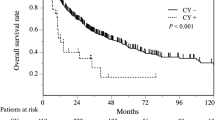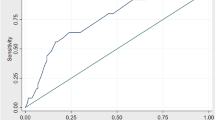Abstract
Background
The clinical importance of positive peritoneal cytology results in patients with pancreatic ductal adenocarcinomas remains controversial. We evaluated the prognosis of these patients and the predictive preoperative risk factors for positive peritoneal cytology results.
Methods
We retrospectively reviewed patients who underwent curative-intent surgery at our institution between May 2010 and June 2020. Preoperative risk factors for positive peritoneal cytology results were identified using logistic regression analysis. A scoring model was constructed using the total number of significant independent predictors for positive peritoneal cytology results.
Results
Of 233 patients, 18 (7.7%) had positive peritoneal cytology results. The recurrence-free survival and cancer-specific survival were markedly worse in patients with positive peritoneal cytology results than in those with negative peritoneal cytology results (recurrence-free survival: 6.0 months vs. 16.6 months, p = 0.050; cancer-specific survival: 19.4 months vs. 47.5 months, p = 0.034). Tumor location (odds ratio: 3.760, 95% confidence interval: 1.099–11.818, p = 0.023), tumor size > 25 mm (odds ratio: 3.410, 95% confidence interval: 1.031–11.277, p = 0.046), preoperative serosal invasion (odds ratio: 5.193, 95% confidence interval: 1.099–24.531, p = 0.038), and preoperative carcinoembryonic antigen level > 5.6 ng/mL (odds ratio: 3.816, 95% confidence interval: 1.248–10.667, p = 0.019) were identified as significant independent predictive factors. Our predictive model’s optimal cutoff and positive predictive values for positive peritoneal cytology results were 3 and 27.9%, respectively.
Conclusions
The indications for curative-intent surgery should be considered carefully in patients with high-risk factors for positive peritoneal cytology results.



Similar content being viewed by others
References
Aletti GD, Gallenberg MM, Cliby WA et al (2007) Current management strategies for ovarian cancer. Mayo Clin Proc 82:751–770
Japanese Gastric Cancer Association (2011) Japanese classification of gastric carcinoma:3rd English edition. Gastric Cancer. 14:101–112
Tempero MA, Malafa MP, Al-Hawary M et al (2017) Pancreatic adenocarcinoma, version 2.2017, NCCN clinical practice guidelines in oncology. J Natl Compr Canc Netw 15:1028–1061
Japan Pancreas Society (2017) Japan Pancreas Society: classification of pancreatic carcinoma 4th English edition. Kanehara, Tokyo
Yachida S, Fukushima N, Sakamoto M et al (2002) Implications of peritoneal washing cytology in patients with potentially resectable pancreatic cancer. Br J Surg 89:573–578
Meszoely IM, Lee JS, Watson JC et al (2004) Peritoneal cytology in patients with potentially resectable adenocarcinoma of the pancreas. Am Surg 70:208–213
Yoshioka R, Saiura A, Koga R et al (2012) The implications of positive peritoneal lavage cytology in potentially resectable pancreatic cancer. World J Surg 36:2187–2191
Hoshimoto S, Hishinuma S, Shirakawa H et al (2017) Prognostic significance of intraoperative peritoneal washing cytology for patients with potentially resectable pancreatic ductal adenocarcinoma. Pancreatology 17:109–114
Tsuchida H, Fujii T, Mizuma M et al (2019) Prognostic importance of peritoneal washing cytology in patients with otherwise resectable pancreatic ductal adenocarcinoma who underwent pancreatectomy: a nationwide, cancer registry-based study from the Japan Pancreas Society. Surgery 166:997–1003
Abe T, Ohuchida K, Endo S et al (2017) Clinical importance of intraoperative peritoneal cytology in patients with pancreatic cancer. Surgery 161:951–958
Satoi S, Murakami Y, Motoi F et al (2015) Reappraisal of peritoneal washing cytology in 984 patients with pancreatic ductal adenocarcinoma who underwent margin-negative resection. J Gastrointest Surg 19:6–14
Yamada S, Fujii T, Kanda M et al (2013) Value of peritoneal cytology in potentially resectable pancreatic cancer. Br J Surg 100:1791–1796
Tanaka M, Mihaljevic AL, Probst P et al (2019) Meta-analysis of recurrence pattern after resection for pancreatic cancer. Br J Surg 106:1590–1601
Nomoto S, Nakao A, Kasai Y et al (1997) Peritoneal washing cytology combined with immunocytochemical staining and detecting mutant K-ras in pancreatic cancer: comparison of the sensitivity and availability of various methods. Pancreas 14:126–132
Igarashi T, Fukasawa M, Watanabe T et al (2023) Evaluating staging laparoscopy indications for pancreatic cancer based on resectability classification and treatment strategies for patients with positive peritoneal washing cytology. Ann Gastroenterol Surg. https://doi.org/10.1002/ags3.12719
Aoki S, Mizuma M, Hayashi H et al (2020) Prognostic impact of intraoperative peritoneal cytology after neoadjuvant therapy for potentially resectable pancreatic cancer. Pancreatology 20:1711–1717
Ariake K, Mizuma M, Motoi F et al (2021) Preceding systemic chemotherapy for patients with pancreatic ductal adenocarcinoma with positive peritoneal cytology provides survival benefit compared with up-front surgery. Ann Surg Oncol 28:6246–6254
Allen VB, Gurusamy KS, Takwoingi Y et al (2016) Diagnostic accuracy of laparoscopy following computed tomography (CT) scanning for assessing the resectability with curative intent in pancreatic and periampullary cancer. Cochrane Database Syst Rev 7:CD009323
Schnelldorfer T, Gagnon AI, Birkett RT et al (2014) Staging laparoscopy in pancreatic cancer: a potential role for advanced laparoscopic techniques. J Am Coll Surg 218:1201–1206
Sell NM, Fong ZV, Del Castillo CF et al (2018) Staging laparoscopy not only saves patients an incision, but may also help them live longer. Ann Surg Oncol 25:1009–1016
Satoi S, Yanagimoto H, Yamamoto T et al (2016) A clinical role of staging laparoscopy in patients with radiographically defined locally advanced pancreatic ductal adenocarcinoma. World J Surg Oncol 14:14
Endo Y, Kitago M, Aiura K et al (2019) Efficacy and safety of preoperative 5-fluorouracil, cisplatin, and mitomycin C in combination with radiotherapy in patients with resectable and borderline resectable pancreatic cancer: a long-term follow-up study. World J Surg Oncol 17:145
Uesaka K, Boku N, Fukutomi A et al (2016) Adjuvant chemotherapy of S-1 versus gemcitabine for resected pancreatic cancer: a phase 3, open-label, randomised, non-inferiority trial (JASPAC 01). Lancet 388:248–257
Yamada S, Takeda S, Fujii T et al (2007) Clinical implications of peritoneal cytology in potentially resectable pancreatic cancer: positive peritoneal cytology may not confer an adverse prognosis. Ann Surg 246:254–258
Kanda M, Kodera Y (2016) Molecular mechanisms of peritoneal dissemination in gastric cancer. World J Gastroenterol 22:6829–6840
Wu W, He J, Cameron JL et al (2014) The impact of postoperative complications on the administration of adjuvant therapy following pancreaticoduodenectomy for adenocarcinoma. Ann Surg Oncol 21:2873–2881
Ito T, Sugiura T, Okamura Y et al (2017) The diagnostic advantage of EOB-MR imaging over CT in the detection of liver metastasis in patients with potentially resectable pancreatic cancer. Pancreatology 17:451–456
Ferrone CR, Haas B, Tang L et al (2006) The influence of positive peritoneal cytology on survival in patients with pancreatic adenocarcinoma. J Gastrointest Surg 10:1347–1353
Chiba K, Hata T, Mizuma M et al (2021) Impact of tumor-derived DNA testing in peritoneal lavage of pancreatic cancer patients with and without occult intra-abdominal metastases. Ann Surg Oncol 29:2685–2697
Suenaga M, Fujii T, Yamada S et al (2020) Peritoneal lavage tumor DNA as a novel biomarker for predicting peritoneal recurrence in pancreatic ductal adenocarcinoma. Ann Surg Oncol 28:2277–2286
Yonkus JA, Alva-Ruiz R, Abdelrahman AM et al (2021) Molecular peritoneal staging for pancreatic ductal adenocarcinoma using mutant KRAS droplet-digital polymerase chain reaction: results of a prospective clinical trial. J Am Coll Surg 233:73-80.e1
Acknowledgements
The authors would like to thank Kazumasa Fukuda, a staff member of the Department of Surgery at Keio School of Medicine, for his help in preparing this article. We would like to thank Editage (www.editage.jp) for their English language editing services.
Funding
The authors declare no source of funding.
Author information
Authors and Affiliations
Corresponding author
Additional information
Publisher's Note
Springer Nature remains neutral with regard to jurisdictional claims in published maps and institutional affiliations.
About this article
Cite this article
Shimane, G., Nakano, Y., Kitago, M. et al. Preoperative predictive factors for positive peritoneal cytology results in patients with pancreatic ductal adenocarcinomas: a retrospective study. Int J Clin Oncol 29, 985–993 (2024). https://doi.org/10.1007/s10147-024-02523-1
Received:
Accepted:
Published:
Issue Date:
DOI: https://doi.org/10.1007/s10147-024-02523-1




